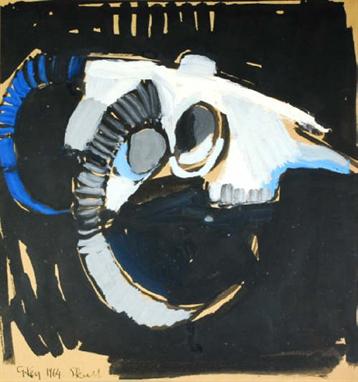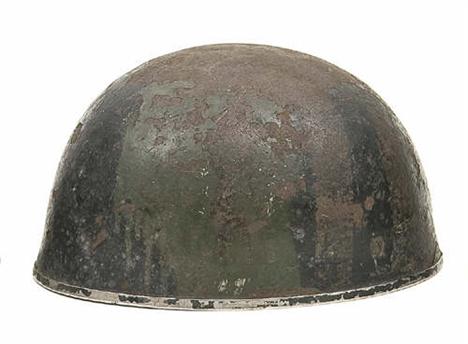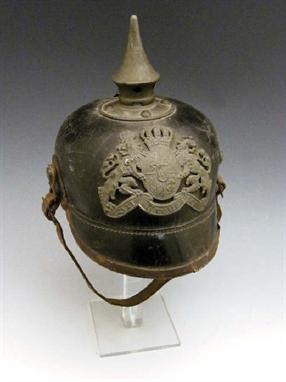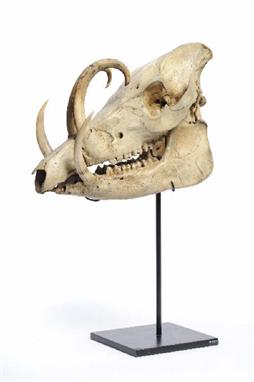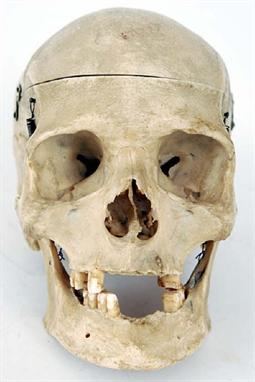We found 19089 price guide item(s) matching your search
There are 19089 lots that match your search criteria. Subscribe now to get instant access to the full price guide service.
Click here to subscribe- List
- Grid
-
19089 item(s)/page
An Edward VII officer's lance cap of The 5th (Royal Irish) Lancers, black patent leather skull, gilt embroidered peak, red cloth sides and top and gilt cross cords, gilt lace bands to waist, gilt and silver plated rayed plate with 7 battle honours "Blenheim" to "S.Africa 1899-1902", gilt rosette with Edward VII cypher, velvet backed chinchain, dark green feather plume in gilt socket, leather and silk lining. Good Condition (light crazing to skull). Plate 5
A WWII British paratrooper's helmet, the skull with traces of black and green camouflage paint, with padded lining, the leather brow band bearing maker's mark "BMB" and name "Andrew McMillan", webbing straps and chin piece; with an accompanying letter from the vendor stating that it was given to him by a friend of his father's who took part in Operation Market Garden, being flown in by glider as he was too young at 17 to be parachuted. Basically GC (some wear). Plate 2
An OR's brass helmet of the 1st (King's) Dragoon Guards, with ear to ear wreath, top mount and spike, WM and brass star HP with no "1" on black PL to centre, leather backed brass chinchain (unstitched) and ear rosettes, red hair plume with small rosette, leather liner. GC (shallow dents to skull). Plate 2
A GOOD EARLY 20TH CENTURY COLOURED PLASTER ANATOMICAL MODEL OF THE FEMALE HUMAN TORSO, with head, unsigned, probably by Adam Rouilly, arranged so as to dismantle for instructional purposes, each organ or component delicately coloured and numbered, the head divided, one half face with glass eye, the other half sectioned so as to show teeth, jaw, brain and skull, all similarly numbered, the front of the torso modelled and painted on the inside with ribs, muscles and tissue, one breast sectioned on shaped plinth base, 36" (91.5cm) high; some old damages and repairs. See Illustration.
A Medici Style Print; depicting a nobleman upon a horse facing a Corpus Christi emanating from a deer. 15½ ins x 18 ins (39 cms x 46 cms). The unusual frame having carved stop-fluted sides and the corners carved with roundels depicting a dodo, owl, heron & skull; 23½ ins x 26 ins (60 cms x 66 cms).
A Bavarian Other Rank's Picklehaube, the black leather skull with grey painted fittings including, spike finial, Bavarian helmet plate (one crown lacking from right hand lion) leather liner, the inside of the neck guard with indistinct Regimental markings "F...", also marked in the crown 57 and with maker's stamp. Visit www.sworder.co.uk for larger image and condition reports.
Dwarf Buffalo or Lowland Anoa (Bubalus mindorensis), Sir Edmund Loder Collection, circa 1900, horns on full skull, right horn 21.5cm, left 21.5cm, tip to tip 15cm, on wood shield with original green stained card label and numbered 326A See illustration. Perhaps the Tamarau or Philippine Buffalo of the island of Mindoro.
Rocky Mountain Bighorn (Ovis canadensis canadensis), Sir Edmund Loder Collection, Montana, US, circa 1900, horns on skull, right horn 78cm, left horn 67cm, circumference 38.5cm, tip to tip 51cm, on oak shield with original green stained card Loder label with pen inscription See illustration
Giant Irish Deer (Megaloceros giganteus), antlers on upper skull, right antler 6 points, left antler 8 points, right antler 123cm, right antler palmation 26cm, left antler 126cm, left antler palmation 29cm, tip to tip 154cm, broadest span 212cm, on wood shield See illustration. This is the skull and antlers of a young stag. Ex Collection of Dublin University. This species of deer is often and erroneously described as an Irish Elk, whereas in fact its nearest relative is the Fallow Deer. This animal was not just particular to Ireland-remains have been found in Japan and China, westward through Asia and Europe. However, most have been found in Ireland, which the deer reached over a land bridge that existed between Cumberland and Ireland via the Isle of Man. It is thought that this species became extinct in Ireland about 10,750-10,250 years ago (about 2,500 years before man first came to Ireland). Giant Deer remains are found in the marls below the peat bogs. The Giant Deer were also 2m tall at the shoulder, and could weigh up to 500kg. Like most living deer, the male and female Giant Irish Deer would have lived in separate herds for much of the year, congregating only for the autumn rut. Large antlers were used for display to both intimidate rivals and impress females, and were also used in combat. The male deer often entered the winter undernourished and in poor condition, sheltering in such narrow steep-sided valleys as that at Ballybetagh, Co Dublin. Here several males died each year on the shores of a shallow lake where their bones would have been trampled by other deer and gnawed by animals such as the Arctic Fox before becoming buried in the lake muds. At Ballybetagh the remains of at least 120 individuals have been discovered, all of them males. The abundance of Giant Deer in Ireland compared with the rest of Europe suggests that condition there were ideal. The abundance also reflects the fact that they were buried in sediments beneath a layer of peat which lead to their discovery as the turf was collected for fuel. Giant Deer remains have also been found in a number of Irish caves, along with bones of Reindeer, Woolly Mammouth, Hyaena and other members of the Ice Age fauna. The final extinction of the Giant Irish Deer came about 10,600 years ago when a cold phase of climate lasting over 400 years caused changes in the vegetation and it became increasingly difficult for the deer to obtain sufficient food to build their large bodies, grow antlers which were shed annually, and build up fat reserves sufficient to survive the winter. The Giant Deer has been known from remains found in Irish bogs since the 16th century. It was first mentioned in print in 1596 when a skull with antlers was presented to Hatfield House in England and recorded in the State papers. The first scientific description was by Thomas Molyneux in 1697, but it was 1813 before the animal was scientifically named by Blumenbach. It is now known as Megaloceros giganteus blumenbach. The National Museum of Ireland has almost 200 specimens of skulls and antlers in its collection.
A Plains Indian Feathered Headdress, with the quills of numerous feathers stitched to the deerskin skull, applied with a band of bow loom woven beadwork decorated with X and lozenge motifs in red, blue, green and white glass beads; two pairs of North American Indian Beadwork Moccasins, each decorated with cruciform and other geometric motifs in pale pink, turquoise, orange and maroon glass beads on a deep pink beaded field, with deerskin soles, one with deerskin cuffs and ties (5)
-
19089 item(s)/page



